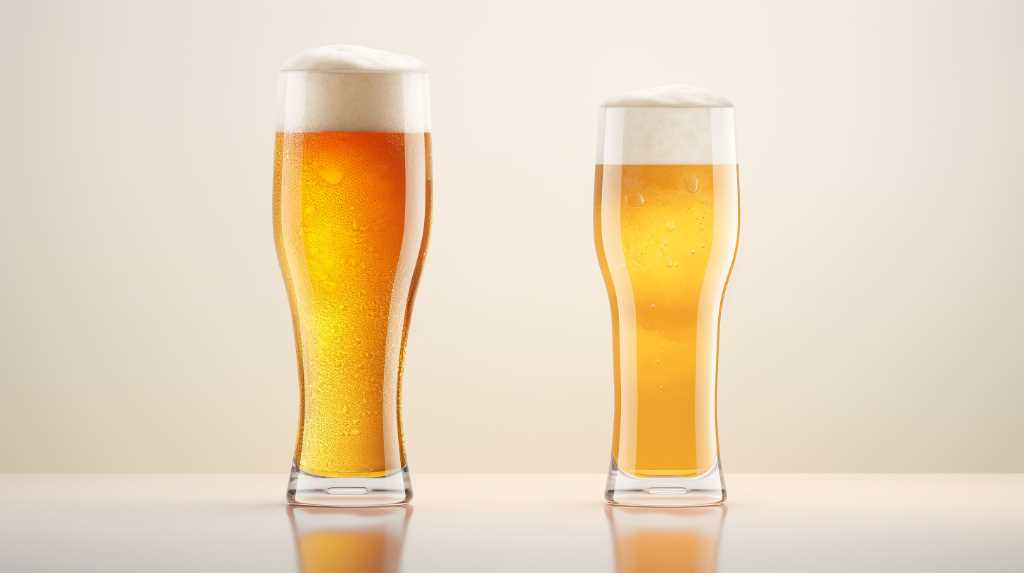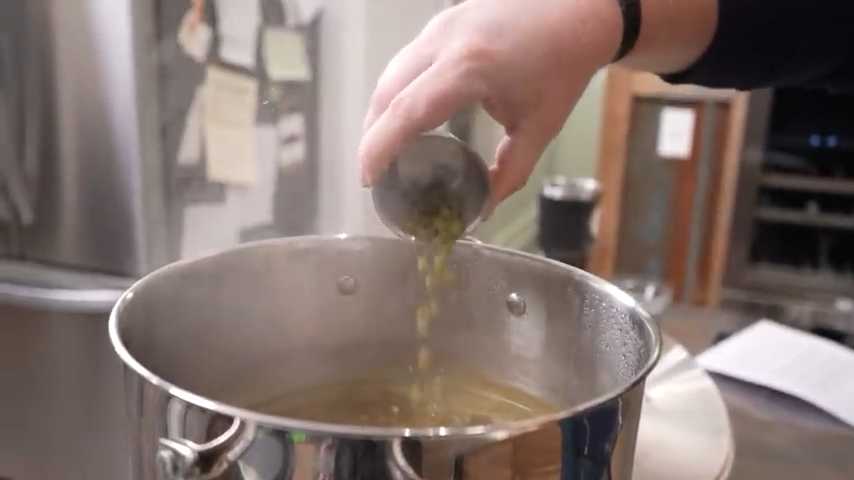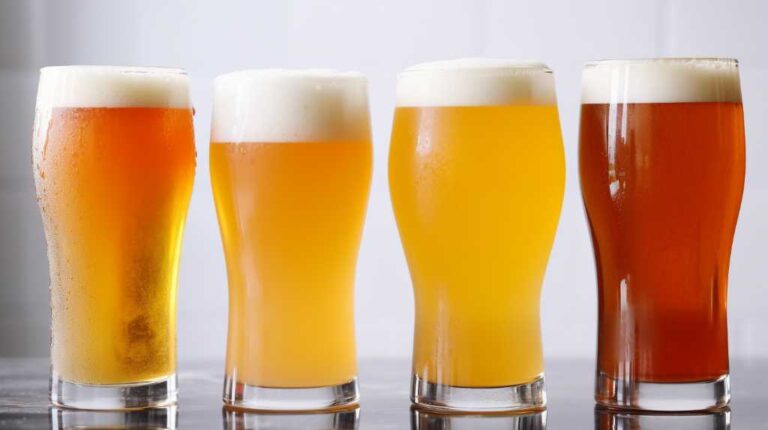What Is The Difference Between Pilsner VS. Lager?

Are you interested in learning about the difference between Pilsner and Lager?
Let’s dive into the world of beer and explore the unique characteristics and brewing methods of these popular styles.
Pilsner, originating from the Czech Republic, has a light golden color and a refreshing taste.

On the other hand, Lager is known for its smoothness and balanced flavor.
Join us on this enlightening journey as we uncover the fascinating distinctions between Pilsner and Lager.
Definition and Characteristics
If you’re curious about the difference between Pilsner and Lager, let’s start by understanding their definitions and characteristics.

Pilsner is a type of beer that originated in Pilsen, Czech Republic. It’s known for its light golden color and clean, refreshing taste. Pilsner is brewed using traditional techniques like decoction mashing and fermentation at low temperatures. It has a translucent golden hue and a lower calorie content.
On the other hand, Lager is a beer that’s fermented and conditioned at low temperatures. It’s characterized by its smoothness and well-balanced flavor. Lagers can have variations in flavor, ranging from malty sweetness to subtle hop bitterness. They’ve a crisp, clean, and lighter body, as well as a longer shelf life.
Both Pilsner and Lager are bottom-fermented beers, each with its own unique brewing techniques and characteristics.
Brewing Process
Let’s take a closer look at the brewing process to understand the difference between Pilsner and Lager beers.

There are three key aspects to consider:
- Yeast selection: Traditionally, Pilsner is brewed using Pilsner yeast, known for its ability to ferment at lower temperatures and produce a clean, crisp flavor. On the other hand, Lager is brewed with bottom-fermenting yeast, which can tolerate a wider range of temperatures during fermentation and lagering stages.
- Temperature variations: Pilsner undergoes fermentation at around 4 degrees Celsius for about 1.5 weeks. It’s then lagered for 5 weeks at a temperature of 0-2 degrees Celsius. Lager fermentation typically lasts 1-3 weeks at temperatures ranging from 4-13 degrees Celsius, followed by a lagering stage of 2-6 weeks at a temperature of 0-2 degrees Celsius.
Understanding these differences in yeast and temperature variations is essential in producing the distinct characteristics of Pilsner and Lager beers.
Ingredients
Understanding the difference between Pilsner and Lager beers requires considering the ingredients used in their brewing process. While Pilsners and Lagers share some common ingredients, there are key differences that contribute to their distinct flavors and characteristics.
The ingredients commonly used in Pilsner brewing include pale malt, Saaz hops, and Pilsner yeast. On the other hand, Lagers utilize a variety of malts, including pale malt, Munich malt, and sometimes caramel malt. Both Pilsner and Lager beers use noble hops for bitterness and aroma. Additionally, adjuncts like corn or rice may be added to Pilsners and Lagers to lighten the body. Water is also crucial in the brewing process of both beer styles.

Flavor Profile
Flavor Profile
When it comes to the flavor profile of Pilsner and Lager beers, there are some notable differences. Let’s explore the taste comparison between Pilsner and Lager:
- Pilsner: Pilsners have a light, crisp, and refreshing flavor with a slightly bitter finish. You may notice floral, spicy, or herbal hop flavors in Pilsners. The crispness and lightness of Pilsners make them a popular choice among beer enthusiasts and casual drinkers alike.
- Lager: Lagers offer a smooth and well-balanced flavor with a clean finish. They can have a range of flavors, including malty sweetness and subtle hop bitterness. Lagers are known for their smoothness and balanced taste, making them a go-to option for many beer lovers.
- Alcohol Content: Both Pilsner and Lager have a moderate alcohol content, which adds to their enjoyable and refreshing nature.
Examples and Popularity
Craft breweries around the world have embraced the popularity of Pilsner and Lager, offering their own unique interpretations of these beloved beer styles. Here is a table showcasing some well-known Pilsner and Lager brands:
| Pilsner Brands | Lager Brands |
|---|---|
| Pilsner Urquell | Heineken |
| Budweiser Budvar | Budweiser |
| Stella Artois | Coors |
These Pilsner and Lager brands are widely available in various countries and regions, making them accessible to beer enthusiasts and casual drinkers alike. In addition to these established brands, craft breweries have also joined the Pilsner and Lager production, creating their own versions of these beer styles. This allows beer lovers to explore a wide range of flavors and characteristics within the Pilsner and Lager categories. With the rising popularity of craft beer, these unique offerings from craft breweries provide a sense of belonging and community for beer enthusiasts who enjoy discovering new and innovative brews.

Pilsner’s Unique Characteristics
Pilsner stands out from other beer styles due to its unique characteristics. Let’s explore what makes Pilsner special:
- Pilsner Ingredients:
- Pilsner is brewed using pale malt, which gives it a light golden color.
- Saaz hops are used in Pilsner, known for their distinct floral and spicy flavors.
- Pilsner yeast is used during fermentation, contributing to its clean and crisp taste.
- Pilsner Brewing Techniques:
- Pilsner undergoes decoction mashing, a traditional brewing method that enhances its complexity and depth of flavor.
- The fermentation stage of Pilsner lasts around 1.5 weeks at a temperature of 4 degrees Celsius.
- Pilsner also goes through a lagering stage that lasts 5 weeks at a temperature of 0-2 degrees Celsius. This process allows the beer to clarify and develop its characteristic smoothness.
The unique combination of ingredients and brewing techniques gives Pilsner its light, crisp, and refreshing taste, with a slightly bitter finish. It’s no wonder that Pilsner has gained a loyal following among beer enthusiasts who appreciate its distinct character and sense of belonging within the Pilsner community.
Lager’s Unique Characteristics
When deciding between Pilsner and Lager, you might be interested in the unique characteristics of Lager.
The brewing process for Lager involves fermentation and conditioning at low temperatures, resulting in a smooth and balanced flavor. During fermentation, bottom-fermenting yeast is used, and the process typically takes 1-3 weeks at temperatures ranging from 4-13 degrees Celsius.

The lagering stage, which follows fermentation, lasts 2-6 weeks at 0-2 degrees Celsius. Lager is brewed using water, grain/barley/malt, hops, and bottom-fermenting lager yeast. It can have a variety of flavors, including a malty sweetness and subtle hop bitterness, with a clean finish.
Lager’s flavor profile is highly regarded for its smoothness and balance, making it a popular choice among beer enthusiasts and casual drinkers who want a refreshing beverage.
Conclusion
To summarize the comparison between Pilsner and Lager, let’s take a closer look at their distinct characteristics and popularity among beer enthusiasts and casual drinkers.
Here are the key differences in brewing Pilsner vs. Lager:

- Pros and Cons of Pilsner vs. Lager:
- Pilsner Pros: Crisp and light flavor, refreshing taste, lower calorie content, translucent golden hue.
- Pilsner Cons: Limited flavor profile, shorter shelf life.
- Lager Pros: Smooth and well-balanced flavor, longer shelf life, cleaner and lighter body.
- Lager Cons: Less distinct flavor, less variety in color.
- Key Differences in Brewing Pilsner vs. Lager:
- Pilsner: Decoction mashing, fermentation at 4 degrees Celsius for 1.5 weeks, lagering at 0-2 degrees Celsius for 5 weeks.
- Lager: Bottom-fermenting yeast, fermentation at 4-13 degrees Celsius for 1-3 weeks, lagering at 0-2 degrees Celsius for 2-6 weeks.
- Popularity: Pilsners and Lagers are widely enjoyed by beer enthusiasts and casual drinkers worldwide. Popular Pilsner brands include Pilsner Urquell and Stella Artois, while well-known Lager brands include Heineken and Budweiser. Craft breweries also produce their own versions of Pilsner and Lager, offering a wide range of options for beer lovers.
Frequently Asked Questions
What Is the History and Origin of Pilsner and Lager?
Pilsner and Lager have interesting histories. Pilsner originated in Pilsen, Czech Republic, while Lager has a long brewing tradition. Both beers undergo fermentation and conditioning at low temperatures, which gives them their unique characteristics. The brewing process plays a crucial role in shaping the flavors and aromas of these beers. Understanding the history and origin of Pilsner and Lager helps us appreciate the craftsmanship and dedication that goes into producing these beloved brews.
How Do the Brewing Processes of Pilsner and Lager Differ From Other Types of Beer?
Craft beer is well-known for its unique brewing techniques. When it comes to Pilsner and Lager, the brewing process sets them apart from other types of beer. Understanding these techniques is key to appreciating the distinct flavors and characteristics of these popular beer styles. Let’s take a closer look at how Pilsner and Lager are brewed and what makes them stand out in the world of beer.
What Are Some Common Misconceptions or Myths About Pilsner and Lager?
There are some common misconceptions about Pilsner and Lager that need to be addressed. Contrary to popular belief, Pilsner isn’t always light and lacking in complexity. It can actually have a rich and complex flavor profile that surprises many. Similarly, Lager isn’t always boring and one-dimensional. In fact, it can offer a wide range of flavors that cater to different tastes. It’s important not to underestimate the true potential of Pilsner and Lager.
Are There Any Health Benefits or Drawbacks Associated With Drinking Pilsner or Lager?
When it comes to the health benefits and drawbacks of drinking pilsner versus lager, it is important to take a scientific perspective. Let’s compare the nutritional value and discuss any potential effects on your well-being.

Pilsner and lager are two popular types of beers that differ in their brewing process and ingredients. Pilsner is known for its light and crisp flavor, while lager has a more balanced and maltier taste. Both beers contain similar amounts of calories and carbohydrates, but the specific nutritional content may vary depending on the brand and brewing method.
In terms of health benefits, moderate beer consumption has been associated with certain advantages. Beer, including pilsner and lager, contains antioxidants and nutrients like B vitamins, silicon, and dietary fiber. These components may contribute to improved bone health, heart health, and digestion. However, it is important to note that excessive alcohol consumption can have detrimental effects on health, so moderation is key.
On the other hand, there are potential drawbacks to consider. Alcohol, including beer, can lead to dehydration and may have negative effects on liver function if consumed excessively. It is also worth mentioning that beer contains alcohol, which can contribute to weight gain and interfere with sleep quality.
Ultimately, the key to enjoying pilsner or lager is moderation. If you choose to drink beer, it’s important to do so responsibly and be aware of your limits. Always prioritize your overall health and well-being, and consult with a healthcare professional if you have any specific concerns or conditions.

Custom Quote: "When it comes to pilsner or lager, moderation is the key. Enjoy your beer responsibly and prioritize your health."
What Are Some Popular Food Pairings or Dishes That Go Well With Pilsner and Lager?
When it comes to pairing food with pilsner and lager, you have a lot of options. Pilsner has a light and crisp flavor that goes well with seafood dishes and refreshing salads. On the other hand, lager’s smoothness complements grilled meats and adds a nice balance to spicy dishes. These beers can enhance the flavors of your favorite foods and make your dining experience even more enjoyable. So, whether you’re indulging in a seafood feast or savoring a juicy steak, pilsner and lager are the perfect companions. Cheers to good food and great beer!






